Erik Ten Hag: We have to make our luck.
The Red Devils’ 4-3 loss at the Allianz Arena comes after back-to-back 3-1 defeats against Brighton and Arsenal in the Premier League, a continuation of United’s negative results at the start of the season.
In his Champions League debut for Bayern Munich, Harry Kane scored his first goal against Manchester United, a team he had been closely linked to before his transfer. Bayern Munich are unbeaten in their last 35 group-stage games and have now won their last 14 in a row!
While some may argue that tactical errors by Erik Ten Hag played a role in the Brighton match, the game in Munich showcased Ten Hag’s adept tactical approach. However, there were differences in player quality, offensive decisions, and other mistakes and critical factors.
This tactical analysis will delve into tactics of what happened.
Lineups
Thomas Tuchel started as usual since his arrival with 4-2-3-1, as the Bavarians did not suffer from multiple absences like their opponent, only the absence of Manuel Neuer.
Bayern Munich XI: Sven Ulreich — Konrad Laimer, Dayot Upamecano, Kim Min-jae, Alphonso Davies — Joshua Kimmich, Leon Goretzka — Leroy Sané, Jamal Musiala, Serge Gnabry — Harry Kane.
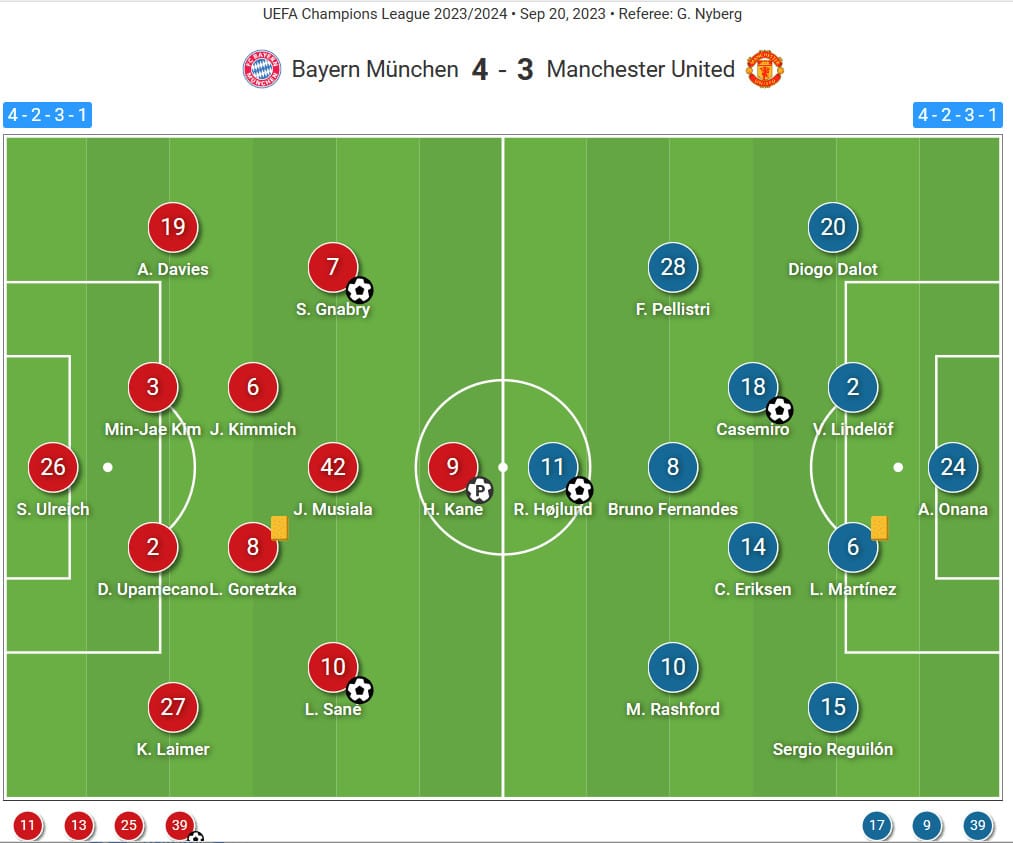
Conversely, Erik Ten Hag reverted to 4-2-3-1 after experimenting with the 4-4-2 diamond. He fielded Pellistri on the right side, a decision which may have been influenced by the numerous absences of players such as Antony and Jadon Sancho.
Man United XI: André Onana — Diogo Dalot, Victor Lindelöf, Lisandro Martínez, Sergio Reguilón — Casemiro, Christian Eriksen — Facundo Pellistri, Bruno Fernandes, Marcus Rashford — Rasmus Højlund.
Structure issues or individual mistakes
Individual errors by players and structural issues are not mutually exclusive for any team but rather interrelated and reinforcing. Structural deficiencies can lead to individual mistakes; conversely, individual errors can often also lead to underlying structural issues.
In the case of Manchester United recently, both aspects were evident. However, during the Bayern Munich game, it was more the individual errors that ultimately had a decisive impact on the outcome.
In possession, Thomas Tuchel, when building, adhered to his 4-2 base—Kimmich and Goretzka operating in the second line just above the defensive back four. Harry Kane drops deeper to the right half-space, while Musiala occupies the left corridor. Gnabry maintained width on the left flank while Sané positioned himself higher up in the right half-space, aiming to manipulate.
In response, Ten Hag employed a hybrid pressing scheme. United’s wingers took up positions inside to block access to the half-spaces and were prepared to press the opposing full-backs if they received the ball. Bruno and Eriksen were marking Bayern’s No. 6s man-to-man.
Meanwhile, Rasmus Højlund typically pressed the ball-carrying centre-back with a curved run to put the other in his back to cover the shadow. Additionally, Casemiro was responsible for staying close to Musiala, and Lisandro Martínez shadowed Kane, ready to cover any potential drops.

When the ball reached the other centre-back, Bruno quickly rushed to press him while covering Kimmich’s shadow, with Højlund returning to mark Kimmich. Simultaneously, the farthest winger (Rashford) pushed to press Upamecano, forcing Kim into making a hasty decision or playing the ball back to the goalkeeper, as seen in the scenario below. This high-intensity press was particularly effective in the early stages of the match.

Bayern concentrated their penetration more from the right side, where Rashford had shown a recent decline in the off-the-ball pressing, sharpness, and ball tracking.
Moreover, Last season, Man United had some problems when pressing (especially the wingers). Still, Ten Hag remedied it somewhat by changing the wingers’ initial positioning and timing of their run at the end of the season.
Upamecano passed the ball to the right full-back, Laimer, who had time and space until Rashford returned to him. Meanwhile, Sané positioned himself more centrally, pulling Reguilón and hindering his ability to press. Lisandro was tracking Kane, which created extra space for Sané.
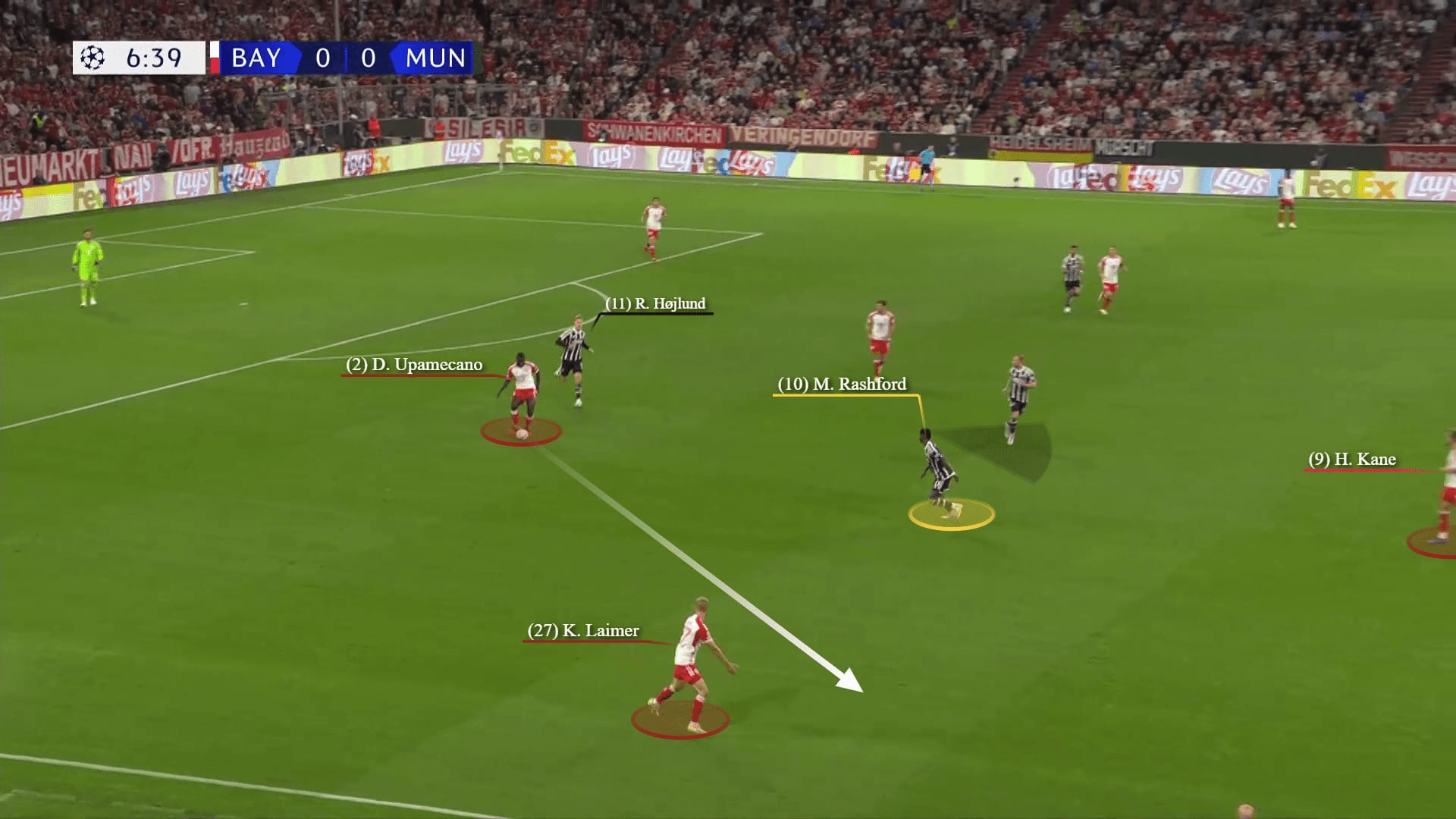

It did not pose significant threats due to Lisandro’s quick reaction and Reguilón’s intensity in his defensive efforts.
What constituted another danger was reaching Musiala between the lines, as Casemiro was suitable for the first 20 minutes, but his level with some others defensively decreased. In this specific instance, there was a miscommunication between Bruno and Casemiro, allowing Musiala to receive the ball between the lines without noise.

As a result, Musiala attempted to put Gnabry to take on Onana, with Lindelöf failing to recogniseE Gnabry’s inward movement. Unfortunately, Lisandro provided solid defensive coverage to thwart the threat effectively.
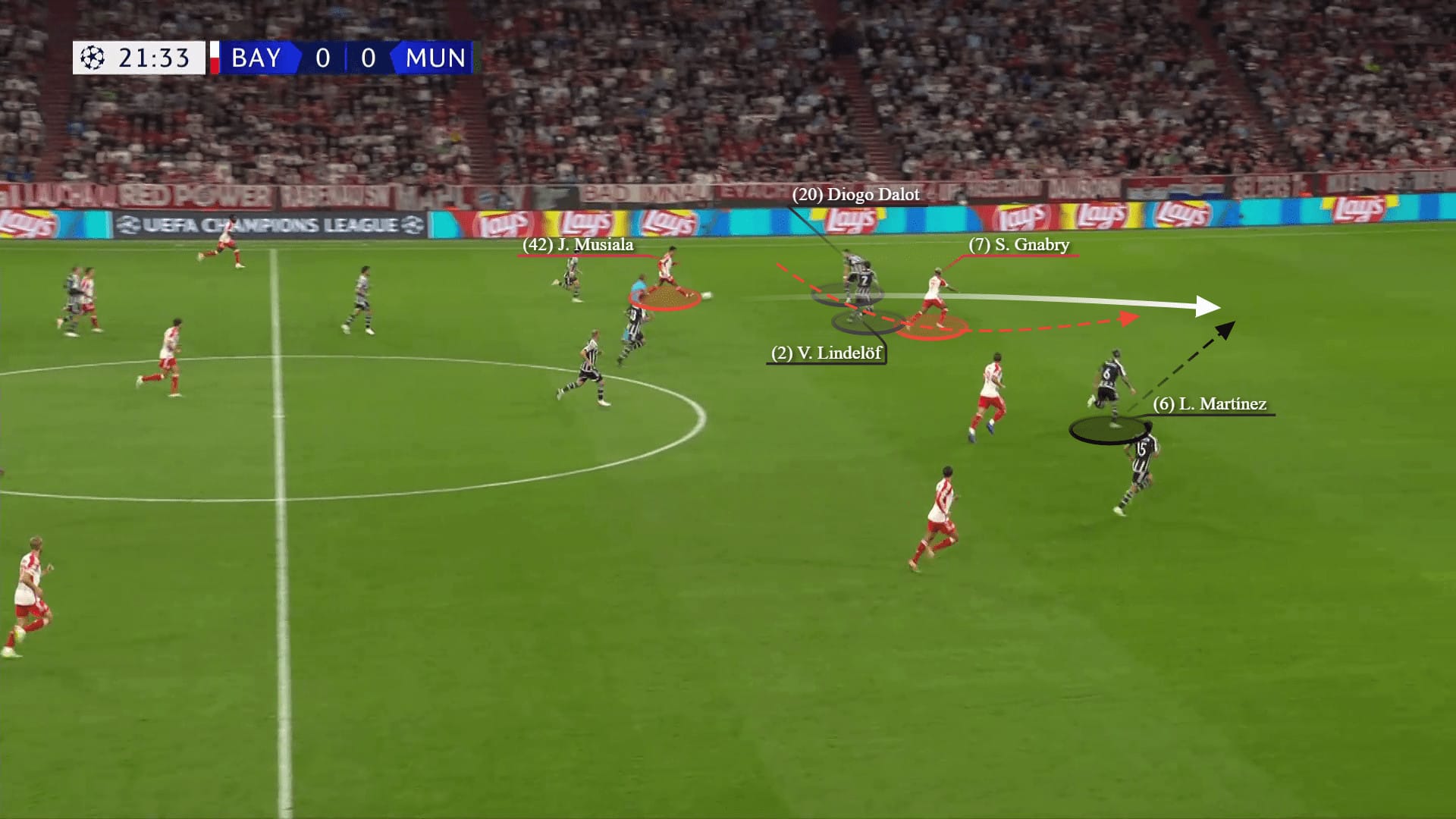
The first goal highlighted the evident lapses in concentration and individual errors.
In this particular play, Sané received the ball in a 2v2 situation. Sané dribbled past Rashford and Eriksen very quickly, then passed the ball to Kane, who executed a brilliant layoff back to him.


This allowed Sané to take a shot under mild pressure from Casemiro without facing a tackle or aggressive interception.
While the shot was somewhat weak, it resulted in a goal due to an apparent mistake by Onana, who said post the game, “Because of me, we didn’t win, but we just have to move on. This is the life of the goalkeeper.”

Immediately afterwards, the scene of the second goal vividly illustrated the lack of pressing intensity among Manchester United’s players in their duels. Furthermore, the physical weakness of the midfield after just 30 minutes of play.
In the described scene, Musiala received the ball from Davies and effortlessly turned past Casemiro (whom United bought last summer for 70 million) with a single fluid movement. Musiala continued to progress without much resistance until he reached the penalty area.

Musiala then played the ball to a completely unmarked Gnabry, who scored the cutback.

This highlighted a recurring issue for United this season: The vulnerability to cutbacks. A significant part of this issue can be attributed to the inadequate positioning of Casemiro and Eriksen in midfield and the backline’s deficiency in anticipation and proactivity. Moreover, part of this complex problem stemmed from tactical structural issues related to the defensive midfielders’ man-to-man pressing in the previous phases.
In the second half, Bayern’s growing ability to find Harry Kane and Jamal Musiala between the lines in both corridors became increasingly evident, exploiting Manchester United’s obvious midfield weaknesses in covering, which posed significant problems and threats.
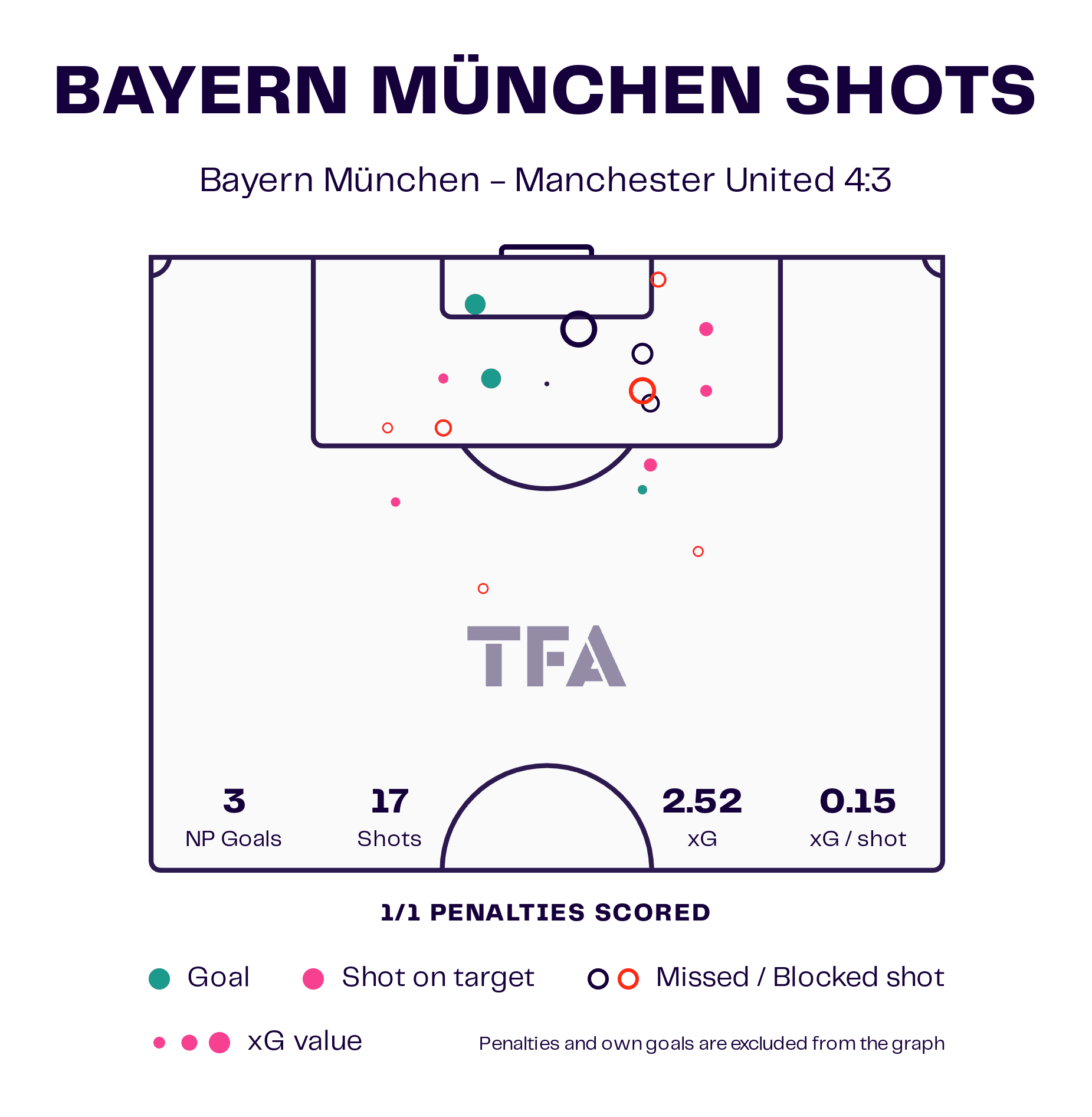
United’s on-ball
Man United displayed moments of good football throughout the match, but critical wrong decisions at crucial junctures made a significant difference.
During the build-up phase, after having André Onana, Ten Hag consistently attempts to build with the lowest players as much as needed and intensify between and last-line players.
Man United used a fluid 3-1/3-2 base, with the centre-backs widening their positioning and Eriksen dropping back when necessary to create the 3-2. In contrast, Bayern adopted a defensive structure resembling both 4-1-3-2 and 4-4-2, depending on the movements of Leon Goretzka and Joshua Kimmich as they tracked Casemiro and Bruno, respectively.

In the game’s early minutes, Onana often resorted to playing long balls, exploiting the gaps and +1 situations created by United players against Bayern’s centre-backs. However, Upamecano and Kim Min-jae eagerly anticipated and intercepted these long balls.

One noteworthy aspect was that Manchester United players successfully won the second balls many times, allowing them to advance into Bayern’s half quickly.
This was also a critical factor in Manchester United’s first goal at the beginning of the second half.
In the below scene, Sergio Reguilón’s cross was intercepted by Kim. The right-back Dalot, positioned inside, tried to win the second ball. However, Musiala displayed quicker reactions, taking a touch that unfortunately reached Bruno around the box…

…who then laid it off to Casemiro. The latter found the third man, Rashford, behind the disorganised backline.

Rashford set it up with one touch for the unbalanced Rasmus Højlund in the centre of the defenders, but he scored brilliantly after Kim’s deflection.


Following around 20 minutes from the start, Manchester United adjusted their approach to penetrate Bayern’s defensive structure. Their players dropped deeper to occupy space and receive the ball between the lines.

The presence of Onana, known for his quality on the ball, combined with Ten Hag’s fluid and intuitive tactical patterns, confused Bayern’s pressing players. In the instance below, Dalot dropped alongside Casemiro, creating uncertainty for Musiala, who was caught between them.

Once he received the ball, Dalot let it and positioned his body positively toward the pitch before advancing.

Upon entering Bayern’s half and facing pressure, Dalot passed the ball back to Casemiro, who expertly played it with one touch into the vacant space where Bruno was excellently positioned.

Bruno, in turn, released Reguilón, allowing him to access Rashford and isolate him against Laimer on the flank.
Rashford, displaying quick footwork, dribbled past Laimer and took a shot, but the goalkeeper blocked the attempt.

During the progression and final third phases, Manchester United-operated 3-1-6, but they encountered challenges in maintaining continuous progressive passes from the first line to the forward line. They employed variations in their penetrations from both flanks, with the left-sided combination between Reguilón and Rashford proving particularly effective, thanks to their chemistry.
In the scenario against Bayern’s 4-4-2 mid-block, Lisandro Martínez had the space to advance with the ball and played it to Rashford, who drifted inside, drawing Laimer with him. Rashford then distributed the ball to the third man, Reguilón on the left.

Reguilón passed to Rashford, who then played it back after dragging Laimer deeper.

Reguilón, after receiving the pass, engaged in a quick 1-2 combination with Casemiro and moved behind Bayern’s defensive line to receive.

His driven cross was on the verge of scoring, but unfortunately, Pellistri was late to join the cross.
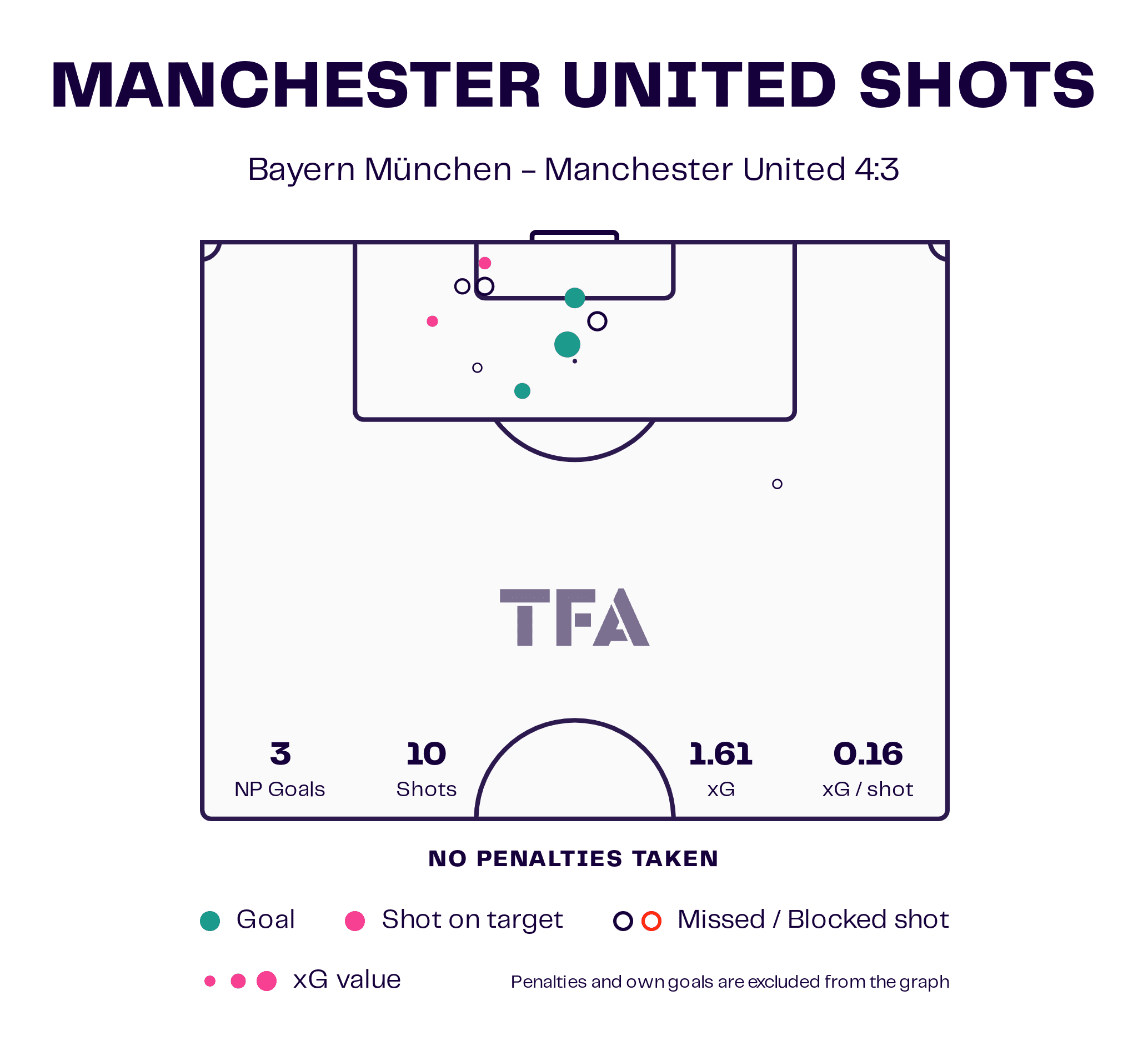
Conclusion
In our analysis, we see that Erik Ten Hag executed a well-thought-out match strategy. However, he faced challenges stemming from the team’s overall quality and occasional lapses in player focus and execution. It’s possible that with the return of injured players, the team’s performance may improve, particularly considering their solid tactical foundation.





Comments